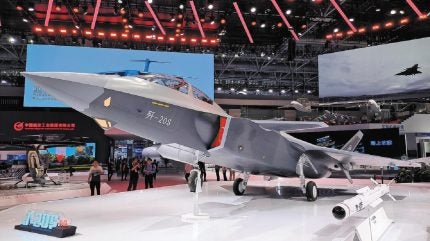
China pulled back the veil on the development of the twin-seat variant of its J-20 fifth-generation stealth fighter at the ongoing China International Aviation and Aerospace Exhibition in Zhuhai, offering a glimpse into the rapid development of Beijing’s defence aerospace capabilities.
In an announcement on 11 November, China’s Ministry of National Defence (MND) revealed state-owned conglomerate Aviation Industry Corp of China had “declassified” the twin-seat J-20 variant, dubbed the J-20S, the only two-seat fifth-generation fighter in the world.
The US operates the single seat F-35 and F-22 fifth generation stealth fighters, with a number of Western allies also operating the F-35 across the conventional take-off and landing A model, as well as the short-take-off, vertical landing B variant.
Aviation Industry Corp of China stated that the J-20S is “a heavy-duty radar-evading fighter jet with long-range operation and multifunction capabilities”, according to the MND, citing a report by the state-owned China Daily news outlet.
The addition of a second seat offers a range of options for China’s People’s Liberation Army Air Force (PLAAF), which currently operate the single seat J-20, to include providing an ability to control uncrewed ‘Loyal Wingman’ drones.
So far, the teaming of crewed and uncrewed combat aircraft is only at its early stages, with no Western fifth generation fighter able in the medium term to operate such a concept through a two-person crew.

US Tariffs are shifting - will you react or anticipate?
Don’t let policy changes catch you off guard. Stay proactive with real-time data and expert analysis.
By GlobalDataIt is thought that the US is debating the future of the sixth generation NGAD (Next Generation Air Dominance) programme due to high costs, with one of its flagship features intended to be the ability to control and operate drone wingmen.
The J-20S appears to be an attempt to integrate such a capability into a fifth-generation design, adding a second crewmember to manage assets such as drones, sensors, and weapons, leaving the lead pilot to manoeuvre the aircraft.
J-20S: an evolution of China’s first stealth fighter
According to the MND the J-20S was designed by the AVIC Chengdu Aircraft Design and Research Institute in Sichuan province based on its J-20 baseline, single-seat model, which is China’s first stealth combat aircraft.
The J-20 conducted its debut flight in January 2011 and was officially declassified in November 2016, when it staged a brief flight performance at the 11th China International Aviation and Aerospace Exhibition.
It was commissioned to the PLAAF later that year, becoming the third stealth fighter jet in the world to enter service following the US’ F-22 Raptor and F-35 Lightning II.
The MND report cited Song Zhongping, a military affairs commentator and retired PLA officer, who said a twin-seat fighter jet is normally operated by a pilot in the front seat and a weapons operator in the rear seat, which means each of them can better focus on their specific tasks.
“According to an introduction from the AVIC, the J-20S has good situational awareness capability, and that means it can act as a small-sized early-warning platform. The new model can also guide drones to carry out strikes against targets. All these new functions promise longer detection and fighting range,” Zhongping said.
Fu Qianshao, an aircraft expert who served with the PLA Air Force for decades, said an extra seat in a stealth fighter has more benefits.
Another expert cited by the MND stated that having a separate weapons operator could enable the J-20S to better operate precision-guided munitions and connect with airborne early warning and control systems.
Stealth fighters central to China modernisation
China is embarking on a wide-ranging military modernisation effort to bring its forces up to parity with, and in some cases surpass, those of its main rival, the United States.
GlobalData’s latest report, “China Defense Market Size and Trends, Budget Allocation, Regulations, Key Acquisitions, Competitive Landscape and Forecast, 2022-27,” reveals that China’s defence expenditure for 2022 would amount to $225.6bn, a 7.3% increase on 2021, and reflects a compound annual growth rate (CAGR) of 7.8% during 2018-2022.

Against this backdrop, China is expected to increase the defence budget at a CAGR of 7.2%, from $241.2bn in 2023 to $318.6bn in 2027, forecasted GlobalData.
The modernisation plans include the procurement of the J-20 Chengdu fifth-generation aircraft to provide critical air support. Work is still ongoing for the Shenyang J-31 programme, another indigenous fifth-generation fighter that follows upon the J-20.



